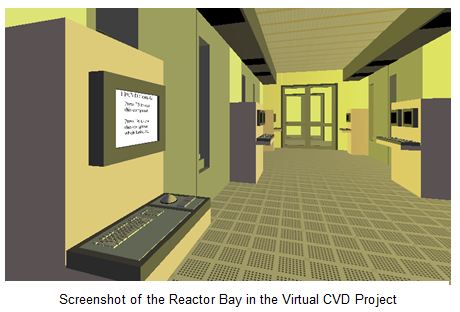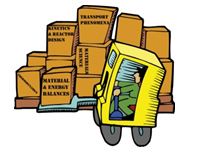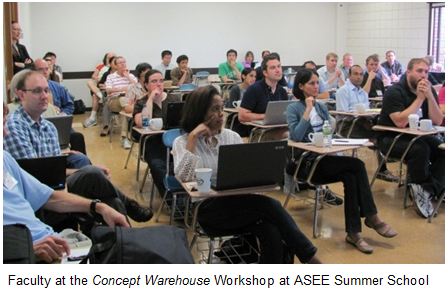The Industrially Situated Virtual Laboratory Project

[http://cbee.oregonstate.edu/education/VirtualCVD/]
The long term goal of the Industrially Situated Virtual Laboratory Project is to contribute to the understanding of how engaging engineering students in authentic, ill-structured engineering tasks enables the development of their engineering knowledge and skills. Since 2005, we have developed, implemented, and studied student learning in cyber-enabled learning systems. Central to each of these learning systems is a virtual reactor that enables a team of students to develop, test, and refine solutions to an engineering process development task. Two virtual reactors have been developed, the Virtual Chemical Vapor Deposition (CVD) Reactor and the Virtual Bio Reactor. Each of these has been integrated into a learning system. We are assessing the effectiveness of these learning systems using qualitative and quantitative methods including by collecting data, including recordings and ethnographic field notes of students and experts as they complete the task, analysis of their work products (e.g., notebooks, reports, presentations), and reflections on the experience after they have completed the task.
The Concept Warehouse

[https://jimi.cbee.oregonstate.edu/concept_warehouse] Oregon State is the lead on this collaborative project with the University of Colorado, Colorado School of Mines, and the University of Kentucky. The goal of this project is to create a community of learning within the discipline of chemical engineering (ChE) focused on concept-based instruction by developing and promoting the use of a cyber-enabled infrastructure for conceptual learning, the AIChE Concept Warehouse. We refer to concept-based instruction as the use of pedagogies and corresponding learning activities whose primary objectives are to make students aware of their need for conceptual understanding and then foster that understanding. The tool provides three distinct but complementary functions: (i) a repository of resources with topic-specific content,  (ii) an audience response system and learning management system to deliver the content, and (iii) learning analytics that provide assessment data of student responses to instructors and researchers. This CW can be used throughout the core ChE curriculum (Material and Energy Balances, Thermodynamics, Transport Phenomena, Kinetics and Reactor Design, and Materials Science). Conceptual questions, both as Concept Inventories and ConcepTests, are available through an interactive website maintained through the Education Division of the American Institute of Chemical Engineers (AIChE), the discipline’s major professional society. We are also integrating more extensive instrutional tools such as inquiry-based activities and interactive virtual laboratories. The overall objective is to lower the activation barrier for using conceptual instruction and assessment so that many more chemical engineering faculty will incorporate concept-based learning into their classes. In the OSU Concept Warehouse, we are extending this project to include pilots in mathematics, chemistry, physics and mechanical engineering.
(ii) an audience response system and learning management system to deliver the content, and (iii) learning analytics that provide assessment data of student responses to instructors and researchers. This CW can be used throughout the core ChE curriculum (Material and Energy Balances, Thermodynamics, Transport Phenomena, Kinetics and Reactor Design, and Materials Science). Conceptual questions, both as Concept Inventories and ConcepTests, are available through an interactive website maintained through the Education Division of the American Institute of Chemical Engineers (AIChE), the discipline’s major professional society. We are also integrating more extensive instrutional tools such as inquiry-based activities and interactive virtual laboratories. The overall objective is to lower the activation barrier for using conceptual instruction and assessment so that many more chemical engineering faculty will incorporate concept-based learning into their classes. In the OSU Concept Warehouse, we are extending this project to include pilots in mathematics, chemistry, physics and mechanical engineering.
Studios in Core CBEE Classes: This project coordinates implementation of studio architecture in nine core CBEE courses. In the studio-based curriculum design, classes are divided with studios interspersed between lectures, and students are afforded the opportunity to actively engage the content presented in the large lectures. The foundation of the studio architecture is based on the demonstrated effectiveness of active learning pedagogies from the physics education research community. These methods seek to promote a substantially higher level of engagement from students during in-class times.
Interactive Virtual Laboratories: The curricular reform in the project is enabled through the creation of computer-enabled Interactive Virtual Laboratories. The design of these laboratories is based on allowing students to see and explore alternative representations of the phenomena that they are learning. They are being developed based on best practices from the literature including the predict, observe, explain technique proposed by Gunstone and Champagne. The simulations allow inquiry-based, scaffolded activity targeted at threshold concepts. Each threshold concept has several activities that provide multiple representations. Whenever possible students are asked to predict and explain the effects of macroscopic changes (i.e., pressure, temperature, composition, energy) based on observations of molecular properties. Activities guide students to perform experiments using the Interactive Virtual Laboratory, but also to place the virtual experiments in the context of the concepts that they are learning.